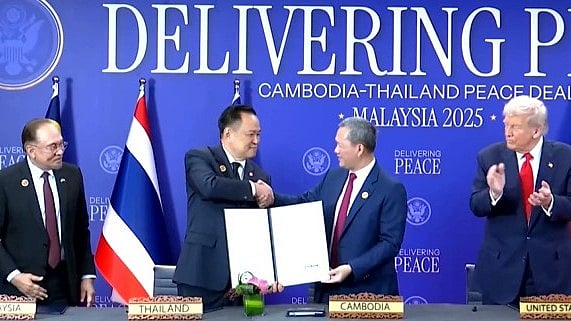World
Thailand, Cambodia expand ceasefire following July border conflict
ASEAN membership gives East Timor access to trade, investment, and broader markets, boosting its economic and regional influence

In a momentous ceremony in Kuala Lumpur, the flag of East Timor — also known as Timor-Leste — was raised alongside those of the other 10 ASEAN nations, marking a historic milestone for the tiny nation and its 1.4 million citizens. For decades, East Timor has dreamed of joining Southeast Asia’s premier regional bloc. On Sunday, that dream became reality.
“Today, history is made,” declared Prime Minister Xanana Gusmao, addressing leaders from across the region. “For the people of Timor-Leste, this is not only a dream realised, but a powerful affirmation of our journey — one marked by resilience, determination, and hope.”
The event, which opened ASEAN’s annual summit, marked the bloc’s first expansion since the 1990s, more than a decade in the making. The accession of East Timor demonstrates ASEAN’s commitment to inclusivity, adaptability, and regional solidarity in a time of geopolitical flux.
The ceremony was attended by world leaders including US President Donald Trump, Chinese Premier Li Qiang, Canadian Prime Minister Mark Carney, and Japan’s newly inaugurated Prime Minister Sanae Takaichi, among others.
Published: undefined
Trump also participated in the signing of a ceasefire agreement between Cambodia and Thailand — ending a summer-long border conflict — and highlighted economic and trade agreements with regional partners, including Malaysia.
For East Timor, ASEAN membership is more than symbolic. With a GDP of around $2 billion, the nation now gains access to a regional economic community of 680 million people and a $3.8 trillion economy, offering a lifeline to a country striving to diversify beyond its depleting oil and gas resources.
“For us, this new beginning brings immense opportunity in trade, investment, education, and the digital economy — we are ready to learn, innovate, and uphold good governance,” Gusmao said. “This is not the end of a journey, this is the beginning of an inspiring new chapter.”
The path to ASEAN membership has been long and arduous. A former Portuguese colony, East Timor declared independence in 1975, only to face a brutal 24-year occupation by Indonesia, which claimed tens of thousands of lives. Following a UN-supervised referendum in 1999, full independence was restored in 2002. Today, the nation is led by independence heroes Prime Minister Gusmao and President Jose Ramos-Horta, the latter a Nobel Peace Prize laureate.
Despite its resilience, the young nation faces significant challenges: high unemployment, widespread poverty (42 per cent live below the national poverty line), and malnutrition, alongside the pressing need to create opportunities for a population where nearly two-thirds are under 30.
“Timor-Leste’s administrative and institutional capacity still lags behind most ASEAN members,” said Joanne Lin of Singapore’s ISEAS–Yusof Ishak Institute, “but its inclusion injects new energy and perspectives, particularly on youth empowerment, democratic governance, and small-state diplomacy.”
ASEAN membership opens the door to free trade deals, regional investment, and broader markets, offering East Timor a chance to transform its economy while contributing its unique voice to the region. Malaysian Prime Minister Anwar Ibrahim, whose country holds the bloc’s rotating chairmanship, hailed the move as a completion of the “ASEAN family” and a reaffirmation of shared destiny and kinship.
As East Timor embarks on this historic journey, the tiny nation stands poised at the threshold of economic opportunity, political affirmation, and renewed hope, ready to carve its place in the heart of Southeast Asia.
With AP inputs
Published: undefined
Follow us on: Facebook, Twitter, Google News, Instagram
Join our official telegram channel (@nationalherald) and stay updated with the latest headlines
Published: undefined